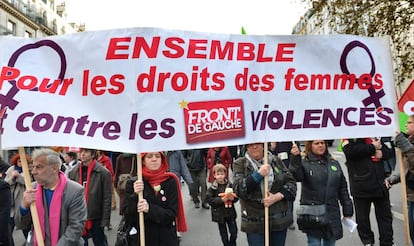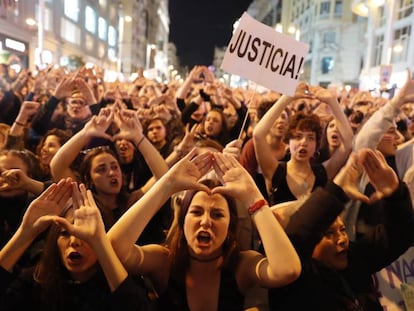“Society still tries to excuse men and blame women for gender violence”
EU equality chief argues lack of standard definitions for abuse hides scale of problem

Virginija Langbakk’s job is the promotion of gender equality in the European Union. As director of the Vilnius-based European Institute for Gender Equality (EIGE), she is battling a situation in which one in every three European women has been the victim of physical or sexual violence.

It’s also a problem underrepresented by the official figures, and one that comes in the context of a situation in which almost half of all people in the bloc believe the most important role of women is taking care of the home. This is why Langbakk highlights the importance of fighting against stereotypes and segregation of the sexes. She also wants to see men more involved in the fight for gender equality. Last but not least, the EIGE director also believes the lack of standard definitions across the EU for what constitutes gender violence is making the problem harder to identify and tackle.
Question. What are the major equality challenges in the EU?
Answer. It is difficult to establish a scale because each problem has an impact. One of them is to minimize segregation of the sexes, something that has a very important impact on society. For example, women are in the majority when it comes to carrying out jobs in the caring professions such as education and health, and these professions are lower paid, something that leads to lower benefits and pensions. They are “women’s jobs” and don’t have the same status, which means as soon as you choose one of these jobs you are condemned to a lower status. We can see it in the case of European Commission funds as well: many of them go to research, innovation and technology – areas where there are hardly any women, which means this money is going to men. And this means only men have access to these funds that we have collected through EU budgets: it also means that technology and innovation are developed and based on ideas oriented towards how men think. If women don’t have an influence, then what is the use of technology designed for only half of society?
In general, victims keep quiet because they feel guilty or ashamed
Q. You speak of the prevalence of stereotypes, which still place women in the home.
A. Stereotypes are critical, not just because they are different in different countries but also because you can’t regulate against them. They can’t be assessed using human rights standards. They are there and they influence us, our children and our grandchildren. And we are still a long way from changing these attitudes that classify women who work with technology as butch and men who work in the caring professions as weak, for example.

Q. One in every three European woman has suffered physical or sexual violence, according to EU data. These are shocking figures for the 21st century.
A. They are. Violence against women is partly the effect and the result of gender inequality, because men believe they have both the right and the power to do what they want: they don’t just see women as property that they can manage and order about, they also see that this is their right as men [to do so]. But we don’t actually know the scale of violence against women in the EU. Official figures only reveal a small part of the picture because many women don’t come forward. Now, with social media, this restraining wall has come down many people are starting to realize there is a problem. But despite the fact that people are talking about the crime more – and more cases are coming to light because victims are supporting each other – there are still a lot of attitudes to do with blaming the woman, the victim, and beliefs that the woman was somehow asking for it.
Official figures only reveal a small part of the picture because many women don’t come forward
Q. How can we fight against gender violence?
A. The institutions can’t ignore the problem. There has to be action, and political commitment – a plan involving all the organizations that fight against violence against women: police, the justice system, social security and health departments [need to be involved]. And the private sector too, such as businesses, so that the problem is known about and can be dealt with. It’s also vital that the definitions of different types of violence are standardized so that EU states understand them in the same way. At present there are countries where touching someone or some forms of sexual abuse are not considered a specific crime, while in others they are. This standardization is also the only way to collect reliable and rigorous data and statistics that can be compared. And it is how police and justice systems will have they information they need.
Q. What do you think of the wave of incidents of sexual abuse being made public because of the case of movie mogul Harvey Weinstein, and which has now spread to Europe?
A. I think it a brave thing to do, to break the ice. And now that this has happened, many women have dared to talk about their own cases of sexual abuse, and sexual abuse in the workplace.
A lot of the time, men, those responsible, are judged far less harshly and women are blamed
Q. Is there an epidemic of harassment? Has it became normalized in society?
A. I think the wound needs to be bleeding for all the poison to come out. A lot of the time, men, those responsible, are judged far less harshly and women are blamed. And now with the social debate that has been generated, it is time for the institutions to take measures. The first step is for people to understand what is acceptable and what is not. And this is where we come back to the [need for standard] definitions among the 28 EU countries. The second thing is to talk about the problem. Many men are now starting to ask themselves if they have ever done anything bad. In the European Parliament, for example, a specific directive has been established and there is a debate about the creation of an independent body that would look at and assist institutions of member states to implement procedures for dealing with sexual abuse cases.
Q. Is the fight against gender violence and for gender equality only a subject for women?
A. Or course not. There is violence toward men too, but the large majority of victims are women. In addition, work has to be done to change men’s attitudes, so that they are less violent and respect women and build more equal relationships.
Q. Beyond campaigns and institutions, what do we need to do?
A. Everyone needs to talk about it with people around them. Speak with your children. They may see cases among their friends or in school and be able to support people who need it. A few years, I fell in the shower and was knocked unconscious. When I woke up I had a cut on my face and blood. In the emergency unit they looked at me. my workmates looked at me, but only one person asked me what had happened. When I was walking on the street with my husband they looked at me and then at him as if he had hit me. But nobody came and asked me if I needed help. This made me think. If I were a victim of gender violence what would I do? Who would I talk to? Where would I go? People can help and we should be aware of small changes among people around us: friends, family and workmates.
What is the use of technology designed for only half of society?
In a lot of countries, this is a private matter. But it is important to help people in the way they need assistance. In general, victims keep quiet because they feel guilty or ashamed.
English version by George Mills.
Tu suscripción se está usando en otro dispositivo
¿Quieres añadir otro usuario a tu suscripción?
Si continúas leyendo en este dispositivo, no se podrá leer en el otro.
FlechaTu suscripción se está usando en otro dispositivo y solo puedes acceder a EL PAÍS desde un dispositivo a la vez.
Si quieres compartir tu cuenta, cambia tu suscripción a la modalidad Premium, así podrás añadir otro usuario. Cada uno accederá con su propia cuenta de email, lo que os permitirá personalizar vuestra experiencia en EL PAÍS.
¿Tienes una suscripción de empresa? Accede aquí para contratar más cuentas.
En el caso de no saber quién está usando tu cuenta, te recomendamos cambiar tu contraseña aquí.
Si decides continuar compartiendo tu cuenta, este mensaje se mostrará en tu dispositivo y en el de la otra persona que está usando tu cuenta de forma indefinida, afectando a tu experiencia de lectura. Puedes consultar aquí los términos y condiciones de la suscripción digital.
More information
Archived In
Últimas noticias
Mexico seeks to shore up its defenses following US incursion in Venezuela
Hope gives way to uncertainty among Venezuelan exiles in the US after Maduro’s capture
Cubans look to Venezuela fearfully after Trump’s incursion: ‘We could be next’
The operation in Venezuela to capture Maduro threatens to widen the cracks in the MAGA movement
Most viewed
- Alain Aspect, Nobel laureate in physics: ‘Einstein was so smart that he would have had to recognize quantum entanglement’
- Gilles Lipovetsky: ‘If you want to live better and fall in love, take Prozac, don’t look to philosophy’
- Alvin Hellerstein, a 92-year-old judge appointed by Bill Clinton, to preside over Maduro’s trial in New York
- Cuba confirms death of 32 of its citizens in the US attack against Venezuela
- Why oil has been at the center of Venezuela-US conflicts for decades










































